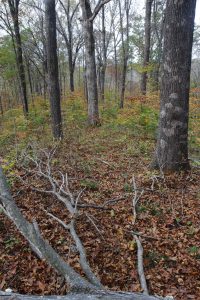Why Our Forests Should Be Managed
By Chris Evans, University of Illinois Extension Forester
Landowners often take the approach of “letting nature take its course” when it comes to their forests. They assume that without human intervention, their forest land will return to a healthy, balanced state. Unfortunately, for the oak hickory forests so common in southern Illinois, this approach will result in a forest that moves gradually toward a much denser, darker forest of beeches and maples with very few plants growing on the forest floor.
How can this be, since nature gave southern Illinois a wealth of open, diverse oak-hickory forests? The secret is disturbance. Those historic forests periodically burned, which gave the fire-resistant, thick-barked oaks and hickories an advantage over the thinner-barked beeches and maples.
Historically most (nearly 70%) of the forests in Illinois were dominated by oaks and hickories. These forests had many other kinds of trees as well, and had a diverse array of plants that grew on the forest floor. These forests were typically much more open than what they look like today. This diversity and structure provided habitat and food for wildlife. The flowering plants on the forest floor were great for pollinating insects. Our forests were alive with action! Dappled sunlight hit the forest floor, providing the light necessary for both new tree seedlings and an abundance of herbaceous plant life. The large oaks and hickories provided food for many species of wildlife. Maples and beeches and other shade-loving tree species were part of the mosaic of Illinois forests, but were restricted to rich, moist coves and other areas that were not prone to fire.
Fire has largely been removed from our forests for the last century and, following the large clear cutting of timber in the early 20th century, many forests have been left to grow largely unmanaged. Without periodic disturbances, many of our forests have slowly closed in and created shaded conditions.

A dense thicket of beech saplings moved into this oak hickory forest due to a lack of periodic disturbance. Now almost no light is available for flowering plants, grasses, or oak seedlings to grow. Photo courtesy Chris Evans.
What we end up with is a forest with the large over-story trees still mostly oak and hickory but now with a very dense layer of maples, beeches and other shade-tolerant species growing underneath of them. This creates so much shade that many plants can no longer grow under the trees, reducing our forest floor to far fewer species than normally would be there. Unfortunately, one plant that does handle this shade very well is poison ivy, now one of the most common plants in our forests. Food is scarce for pollinating insects who are now relegated to the forest edges, along trails, and other areas where enough light sneaks in to let some flowering plants grow. Without adequate numbers of seedlings established in the forest, when those large old oaks and hickories die, instead of being replaced by their offspring they are being replaced by maples, beeches, and other shade-tolerant species.
So what can be done to get our plant diversity back and to make room for new oaks and hickories to grow and create a healthy, diverse, open forest more like the forests of the past? One important thing is to bring fire back to our forests. Regular prescribed fires can slowly thin out the forest, creating light for tree seedlings and other plants to grow.

Thinning can remove larger shade-tolerant trees that are too big to be removed by prescribed fires alone. This gives space and light needed to restore the herbaceous plants on the forest floor and for new oak and hickory seedlings. Photo courtesy Chris Evans.
In many cases, our forests have closed in so much and the shade-loving trees are so large now that fire may not be enough to turn things around. Thinning some of these trees through cutting is an effective forest management practice. Thinning not only helps to create the light conditions for a healthy forest, it can help ‘release’ certain trees, providing more room for them to grow. Thinning around desirable trees reduces competition and allows that tree to develop a bigger canopy and grow faster. Release cuts like this are often used when managing for timber, to concentrate the growth of a forest into certain trees. It can also be very useful for wildlife. Healthier trees with larger canopies will produce more fruit. Acorns and hickory nuts, called hard mast, are extremely valuable food sources for many wildlife species and a well-managed forest will produce more hard mast.

Prescribed fire and thinning are often used in combination. Here the dense mid-story of maples and beech were reduced through thinning. Prescribed fire will help reduce the remaining small seedlings. Photo Courtesy Chris Evans.
The forests of Illinois developed with regular disturbances, including fire. Over the last 100+ years we have largely removed those disturbances from the forests. Illinois forests today are more crowded with trees and much darker than before. Our forests need management, and a combination of fire and thinning can help bring back the diversity and wildlife.
CLIFFTOP, a local nonprofit organization, is focused on preserving and protecting area blufflands.
A version of this article appeared in the March 15, 2019 edition of the Monroe County Independent.
©2019 all content rights reserved Clifftop NFP
Comments are currently closed.
